Power electronic handbook
Подождите немного. Документ загружается.


1118 A. M. Trzynadlowski
Special Committee on Radio Interference (CISPR), both
already mentioned in the introduction to this chapter. The
series of IEC standards, IEC 61000-1 through IEC 61000-6,
covers all aspects of EMC. The FCC standards are harmonized
to IEC, as are the European Norms (EN) used in the European
Union (EU). Some specific EMC standards have also been
published by International Organization for Standardization
(ISO).
In 1992, the EU eliminated internal borders, necessitat-
ing a common system for establishing EMC standards and
accreditation, testing, and certification procedures. The “New
Approach” and “Global Approach” have been initiated, whose
goal is to include EU directives into national laws of EU states,
harmonize national standards with the European standards,
and ensure validity of test reports and conformity certificates
between all Member States.
According to the “New Approach,” technical contents
have been removed from the European Directives and
entrusted to the European Standardization Bodies, which
are Comitè Europèen de Normalization (CEN), Comitè
Europèen de Normalization Electro-Technique (CENELEC),
and European Telecommunication Standards Institute (ETSI).
The key European Directive 89/336/EEC “Electromagnetic
Compatibility” gives only a general definition of the essen-
tial protection requirements for all electric and electronic
equipment and systems, while referring to CENELEC and
ETSI standards for technical details. The “Global Approach”
requires every product on the European market to have the
permanent “CE” marking, which indicates that the affixer
declares, and takes full responsibility of, the conformity to all
applicable European directives.
The EMC Directive 89/336/EEC sets up emission and
immunity requirements. It defines (a) components, (b) sys-
tems, and (c) installations. The Directive applies only to
components performing direct function and to the systems.
Standards referred to in the Directive are divided into basic
standards, generic standards, and product standards. The basic
standards define general EMC requirements and testing pro-
cedures, without specifying any limit values or assessment
criteria. Generic standards specify the requirements for prod-
ucts in specific electromagnetic environments. For instance,
EN 50081-1 applies to emissions in residential, commercial,
and light industrial equipment, the latter including power
supplies for industrial equipment, and EN 50081-2 to emis-
sions in industrial environments. Respective immunity norms
are EN 50082-1 and EN 50082-2. Product standards address
EMC requirements for certain products and product families,
such as household appliances, information technology equip-
ment, or generic light industrial equipment, Various European
Norms are employed as the product standards.
The IEC 555-2 (EN 60555-2), IEC 1000-3-2 (EN 61000-
3-2), and IEC 1000-3-4 are emission standards for low-
frequency harmonics, closely associated with operation of
power electronic converters. Voltage fluctuations and flicker
(impression of unsteadiness of visual sensation induced by a light
stimulus whose luminance or spectral distribution fluctuates in
time) emission limits are defined in IEC 555-3 (EN 555-3),
IEC 1000-3-3 (EN 61000-3-3), and IEC 1000-3-5. IEC 61000-
4-7 and IEC 61000-4-15 define the required instrumentation
for EMI measurements. Radio-frequency conducted and radi-
ated emissions are dealt with in EN 55011, EN 55014, and
EN 55022, while CISPR 16 is the basic standard for radio-
interference measurements. Finally, IEC 1000-4-1 through IEC
1000-4-12 are immunity standards.
EMC standards are continuously being developed and
revised. Therefore, it is important to keep track of standards’
publication dates (DoP) and dates of withdrawal (DoW) of
conflicting earlier standards. Temporary EN standards are
called ENV. Numerous Internet resources are available, in
particular:
• American National Standards Institute (ANSI).
• Canadian Standards Association.
• Electronic Industries Association (EIA).
• European Telecommunications Standards Institute
(ETSI).
•
Federal Communications Commission (FCC).
•
IEEE Standards Association.
• International Electrotechnical Commission (IEC).
• International Organization for Standardization (ISO).
• National Institute of Standards and Technology (NIST).
• NSSN, A National Resource for Global Standards.
• Society of Automotive Engineers (SAE).
• Standards Australia.
• VCCI (Japanese EMC Regulation and Certification).
• Verband Deutscher Elektrotechniker e. V. (VDE -
German standards).
For more EMC information links go to http://www.
dbtechnology.co.uk/links.htm. A comprehensive treatment of
contemporary EMC issues can be found in [13].
References
1. D. A. Weston, “Electromagnetic Compatibility: Principles and Appli-
cations,” 2nd Ed., Marcel Dekker, New York, 2001.
2. J. J. Carr, “The Technician’s EMI Handbook,” Nevnes Press, Woburn,
2000.
3. M. Mardiguian, “EMI Troubleshooting Techniques,” McGraw Hill,
New York, 1999.
4. C. R. Paul, “Introduction to Electromagnetic Compatibility,” John
Wiley, New York, 1992.
5. H. W. Ott, “Noise Reduction Techniques in Electronic Systems,” 2nd
Ed., John Wiley, New York, 1988.
6. L. Tihanyi, “Electromagnetic Compatibility in Power Electronics,”
IEEE Press, New York, 1995.
7. R. L. Ozenbaugh, “EMI Filter Design,” 2nd Ed., Marcel Dekker,
New York, 2001.

40 EMI Effects of Power Converters 1119
8. M. J. Nave, “Power Line Filter Design for Switched-Mode Power
Supplies,” Van Nostrand Reinhold, New York, 1991.
9. R. L. Kirlin, M. M. Bech, and A. M. Trzynadlowski, “Analysis of
Power and Power Spectral Density in PWM Inverters with Ran-
domized Switching Frequency,” IEEE Transactions on Industrial
Electronics, vol. 49, no. 2, pp. 486–499, Apr. 2002.
10. M. Vilathgamuwa, J. Deng, and K. J. Tseng, “EMI Suppression with
Switching Frequency Modulated DC-DC Converters,” IEEE Industry
Applications Magazine, vol. 5, no. 6, pp. 27–33, 1999.
11. A. M. Trzynadlowski, M. Zigliotto, and M. M. Bech, “Random
Pulse Width Modulation Quiets Motors, Reduces EMI,” PCIM Power
Electronics Systems Magazine, pp. 55–58, Feb. 1999.
12. G. L. Skibinski, R. J. Kerkman, and D. Schlegel, “EMI Emissions
of Modern PWM AC Drives,”IEEE Industry Applications Magazine,
vol. 5, no. 6, pp. 47–80, 1999.
13. L. Rosetto, P. Tenti, and A. Zuccato, “Electromagnetic Compatibility
Issues,” IEEE Industry Applications Magazine, vol. 5, no. 6, pp. 34–46,
1999.

41
Computer Simulation of Power
Electronics and Motor Drives
Michael Giesselmann, P. E.
Center for Pulsed Power and Power
Electronics, Department of
Electrical and Computer
Engineering, Texas Tech
University, Lubbock,
Texas, USA
41.1 Introduction ........................................................................................ 1121
41.2 Use of Simulation Tools for Design and Analysis........................................ 1121
41.3 Simulation of Power Electronics Circuits with PSpice
................................ 1122
41.4 Simulations of Power Electronic Circuits and Electric Machines.................... 1128
41.5 Simulations of AC Induction Machines Using Field Oriented (Vector) Control 1131
41.6 Simulation of Sensorless Vector Control Using PSpice
............................... 1135
41.7 Simulations Using Simplorer
................................................................ 1141
41.8 Conclusions ......................................................................................... 1144
References ........................................................................................... 1145
41.1 Introduction
This chapter shows how power electronics circuits, electric
motors, and drives, can be simulated with modern simula-
tion programs. The main focus will be on PSpice
, which
is one of the most widely used general-purpose simulation
programs and Simplorer
, which is more specialized towards
the power electronics and motor drives application area. Ali
Ricardo Buendia, who obtained his M.S.E.E. degree from Texas
Tech University, has created the examples for Simplorer
. The
PSpice
examples have been developed for the free student
version of OrCAD Capture 9.1 from Cadence. The author
found the use of examples that can be run on the student ver-
sion very beneficial in an educational environment, since such
examples can be shared with students to enhance their under-
standing of the lecture material. This shall by no means lead to
the conclusion, that the programs and simulations presented
here cannot be used for serious professional work. In fact, the
author has used these tools with great success in many research
and consulting projects. In addition to the programs men-
tioned above, MathCAD
has been used to derive and present
the underlying equations. The advantage of using MathCAD
for this purpose is that in MathCAD
it is possible to check
equations by actually executing them.
The examples have been developed to illustrate advanced
techniques for simulation of systems from the power elec-
tronics and drives area but not to teach the basic features
of the individual programs. It is assumed, that the reader
will familiarize themself with the basics on how to run the
programs using the accompanying documentation. In addi-
tion, it is assumed, that the reader is familiar with the
basics of power electronics and electric machines, specifi-
cally AC induction machines. For a review the reader shall be
referred to [1] for power electronics and [2, 3] for induction
machines.
41.2 Use of Simulation Tools for Design
and Analysis
It is appropriate to reflect upon the value of simulations and
its place in the design and analysis process before any in-depth
discussion of specific simulation examples. Computer simula-
tions enable engineers to study the behavior of complex and
powerful systems without actually building or operating them.
Simulations therefore have a place in the analysis of existing
equipment as well as the design of new systems. In addition,
computer simulations enable engineers to safely study abnor-
mal operating or fault conditions without actually creating
such conditions in the real environment.
However, the reader should be reminded that even the most
modern simulation programs cannot perfectly represent all
parameters and aspects of real equipment. The accuracy of the
Copyright © 2007, 2001, Elsevier Inc.
All rights reserved.
1121

1122 M. Giesselmann
simulation results depends on the accuracy of the component
models and the proper identification and inclusion of parasitic
circuit elements such as parasitic inductance, capacitance, and
mutual coupling. Accuracy of component models in this con-
text shall not mean that the model is actually faulty but rather
that the limitations of the model are exceeded. For exam-
ple, if the transformer inrush phenomenon were to be studied
using a linear model for a transformer, the simulation would
not yield useful results.
In particular, the precise prediction of voltage and current
traces during fast switching transitions in power electronics
circuits has been proven to be difficult. To obtain useful
results, extensive experimental validation, advanced device
models (and the values for their parameters!), and detailed
knowledge of parasitic elements, including the ones of the
packaging of the circuit elements, are necessary. In addition,
numerical convergence is often a problem, if gate-drive signals,
with rise and fall times as steep as in real circuits, are applied.
Therefore, the exact prediction of waveforms during switch-
ing transitions shall be excluded from the discussions in this
chapter. Consequently, the author prefers to measure param-
eters such as voltage rise and fall times, over and undershoot
etc. on actual circuitry in the laboratory.
Sometimes, users of PSpice
claim that the convergence
problems are so severe, that it’s use for simulations of power
electronics circuits is just not possible or worth the effort.
However, this is absolutely not true and with the proper tech-
niques of gate signal generation, we can simulate just about any
given circuit with little or no convergence problems. In addi-
tion, if convergence problems are avoided, simulations run
much faster and larger numbers of individual transitions can
be studied. This is achieved by generating gate signals that are
slightly less steep than in real circuits using analog behavioral
elements. This gives a lot of insight into the cycle-by-cycle
as well as the system level behavior of a power electronics
circuit. In this fashion, the function of an existing, as well
as the expected performance of a new proposed circuit can be
studied. An excellent application for these cycle-by-cycle simu-
lations is the development and verification of control strategies
for the power semiconductors.
Analog behavioral modeling (ABM) techniques included
in PSpice
can be used to study large and complex systems
like the control of induction machines using field oriented
(also called vector) control techniques. Examples are given
that replace the power electronics inverter with an ABM
source that produces voltages, which represent the short-
term average (filtering away the voltage components of the
switching frequency and above) of the output of a three-
phase inverter. These examples represent pure system level
simulations, which could have also been done using programs
like MatLab/Simulink
. However, circuit simulation programs
provide the option of studying actual circuit level details in
complex systems. To demonstrate this capability, the start-up
of an induction motor, fed by a three-phase metal oxide
semiconductor field effect transistor (MOSFET) inverter, is
presented.
In all modeling cases, the user needs to define the goal of
the simulation effort. In other words, the user must answer the
question “What information shall be obtained through the
simulation of the circuit or system?” The user must then
select the appropriate simulation software and the appropri-
ate models. This process requires a detailed understanding of
the properties and limitations of the device models and the
sensitivity of the results to the model limitations. In order to
obtain such an understanding, it is often recommended and
necessary to perform numerous simulation test runs, carefully
scrutinize the results and compare them with measured data,
results from other simulation packages or otherwise known
facts.
41.3 Simulation of Power Electronics
Circuits with PSpice
The first example of a power electronics circuit is a step-down
(also called buck) converter with synchronous rectification.
For the purpose of synchronous rectification, the diode, which
connects the inductor to ground in the regular circuit, is
replaced with a power MOSFET transistor. The benefit of this
circuit is that the power MOSFET represents a purely resistive
channel in the on state. This channel does not have a residual,
current independent, voltage drop like the p–n junction of a
diode. Therefore, the voltage drop across the MOSFET can
be made lower than what can be achieved with diodes. The
results are reduced losses and increased efficiency. To achieve
this, the lower MOSFET must be turned on whenever the
upper MOSFET is turned off and the current in the induc-
tor is positive. If the current in the inductor is continuous,
the drive signal for the lower MOSFET is simply the inverted
drive signal for the upper MOSFET. However, if the current
in the inductor is discontinuous, the drive signal for the lower
MOSFET must be cut off as soon as the current in the inductor
goes to zero.
Figure 41.1 shows a simulation setup for a synchronous
buck converter that can operate correctly for continuous as
well as discontinuous inductor current. As mentioned before,
the key element of this example is the circuit for the genera-
tion of the gate-drive signals for the MOSFETs. For clarity, this
circuit has been realized using only standard elements from
the libraries of the evaluation version. The basic principle of
the operation of the gate-drive circuit is the well-known car-
rier based scheme, where a control voltage is compared with
a triangular carrier with fixed amplitude. An “ABM” block,
shown in the lower left part of Fig. 41.1, generates the trian-
gular carrier. Equation (41.1) shown below gives the closed
form equation for the triangular carrier wave. The output
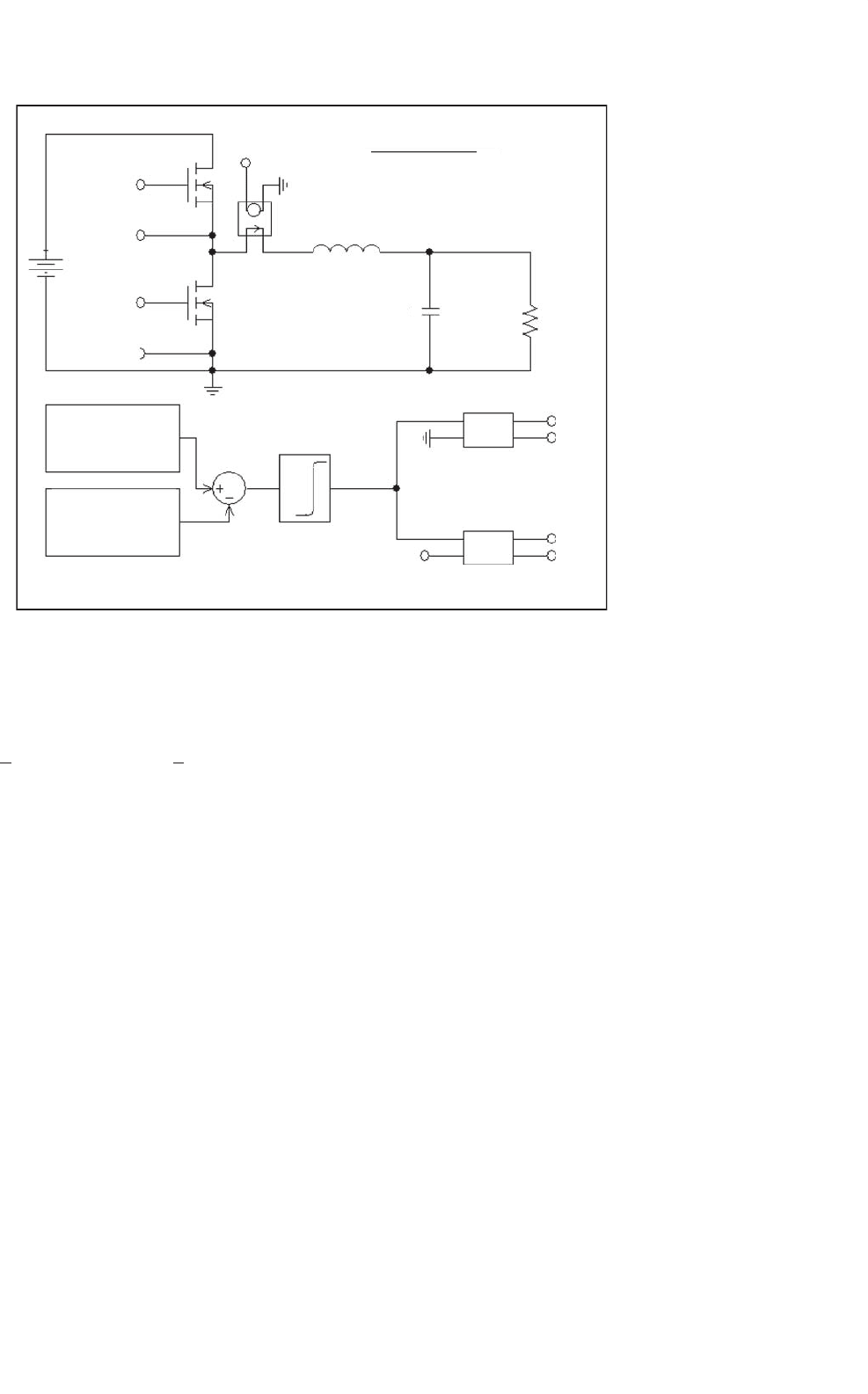
41 Computer Simulation of Power Electronics and Motor Drives 1123
In
IL
H1
L1
60
0.5
Triangle
IL
1k
PWM
+15
−15
2 −
E −
IN–OUT −
IN–OUT −
IN–OUT +
IN–OUT +
EVALUE
EVALUE
2 +
1 −
1 +
E +
20uF
IC = 0V
C1
Out
Rload
M2
50V
Vin
IRF150
IRF150
M1
1+
2+
1−
2−
1mH
PARAMETERS:
F
SW = 10k
PI = 3.14159265
(1/Pi)*
Acos(Cos
(2*Pi*Fsw*Time
+Pi/2))
IF(V(%IN+)<
–2, IF(V(%IN–)>40m, –V(%IN+),0),0)
IF(V(%IN+)>2, V(%IN+),0)
+
FIGURE 41.1 Simulation setup for a synchronous buck converter.
range of the function shown in Eq. (41.1) is between 0.0
and 1.0.
E
Tri
(
t
)
:=
1
π
acos
cos
2πFswt +
π
2
(41.1)
For the generation of the gate-drive signals, the carrier
wave is compared with a control signal that can have val-
ues between 0.0 and 1.0, corresponding to a duty cycle input
between 0 and 100%. Feeding the difference of the carrier
wave and the control signal into a soft comparator generates
the primary PWM signal. Careful inspection of the implemen-
tation of the soft-limiter element provided in the evaluation
version of PSpice
shows that it uses a scaled hyperbolic tan-
gent function. Figure 41.2 shows a plot of a hyperbolic tangent
function. It can easily be seen, that the result of the soft-limiter
is an output signal with smooth transitions, which is crucial
to avoid convergence problems in PSpice
. The soft-limiter
used here has an upper and lower limit of ±15 V and a gain
(steepness control for the tanh function) of 50.
Figure 41.3 shows the output of the simulation run for the
synchronous buck converter. The top-level graph shows the
generated triangle carrier. It has a frequency (Fsw, see param-
eter statement in Fig. 41.1) of 10 kHz. This frequency has been
chosen rather low to improve the readability of Fig. 41.3. In the
graph of the triangle voltage in Fig. 41.3, the gate-drive signals
are shown for both MOSFET transistors. Please note, that the
gate-drive signal for the lower MOSFET is vertically shifted
by 30 V in order to separate the traces for readability. The
graph below the gate-drive signals shows the inductor current.
It can be seen that the current is discontinuous after the initial
inrush peak. The inrush peak is caused by the fact that the
capacitor is initially discharged (IC = 0 V). It is evident, that
the gate-drive signal of the lower (synchronous rectification)
MOSFET is appropriate for the inductor current. The bot-
tom trace shows the capacitor voltage, which has a steady-state
value of slightly more than 0.5 × 40 V (0.5 = 50% being the
duty cycle and 40 V being the input voltage) due to the fact that
the inductor current is slightly discontinuous even at steady-
state conditions. To test the gate-drive circuit for the lower
MOSFET, the load has been chosen such that the steady-state
current would be discontinuous. Following the soft-limiter are
two voltage-controlled voltage sources that generate isolated
gate-source voltages of 15 V for the on condition and 0 V for
the off condition of the MOSFETs. To enable operation with
discontinuous inductor current, the source “E−” in Fig. 41.1
also monitors the polarity of the inductor current through a
current-controlled voltage source “H1” with unity gain.
In addition to the cycle-by-cycle simulation of a DC–DC
converter, it is also possible to use a time-averaged replacement
for the MOSFET transistors used in the circuit in Fig. 41.1.
In fact, a common time-averaged model can be used for the
buck, the boost, the buck–boost, and the Cuk converter as
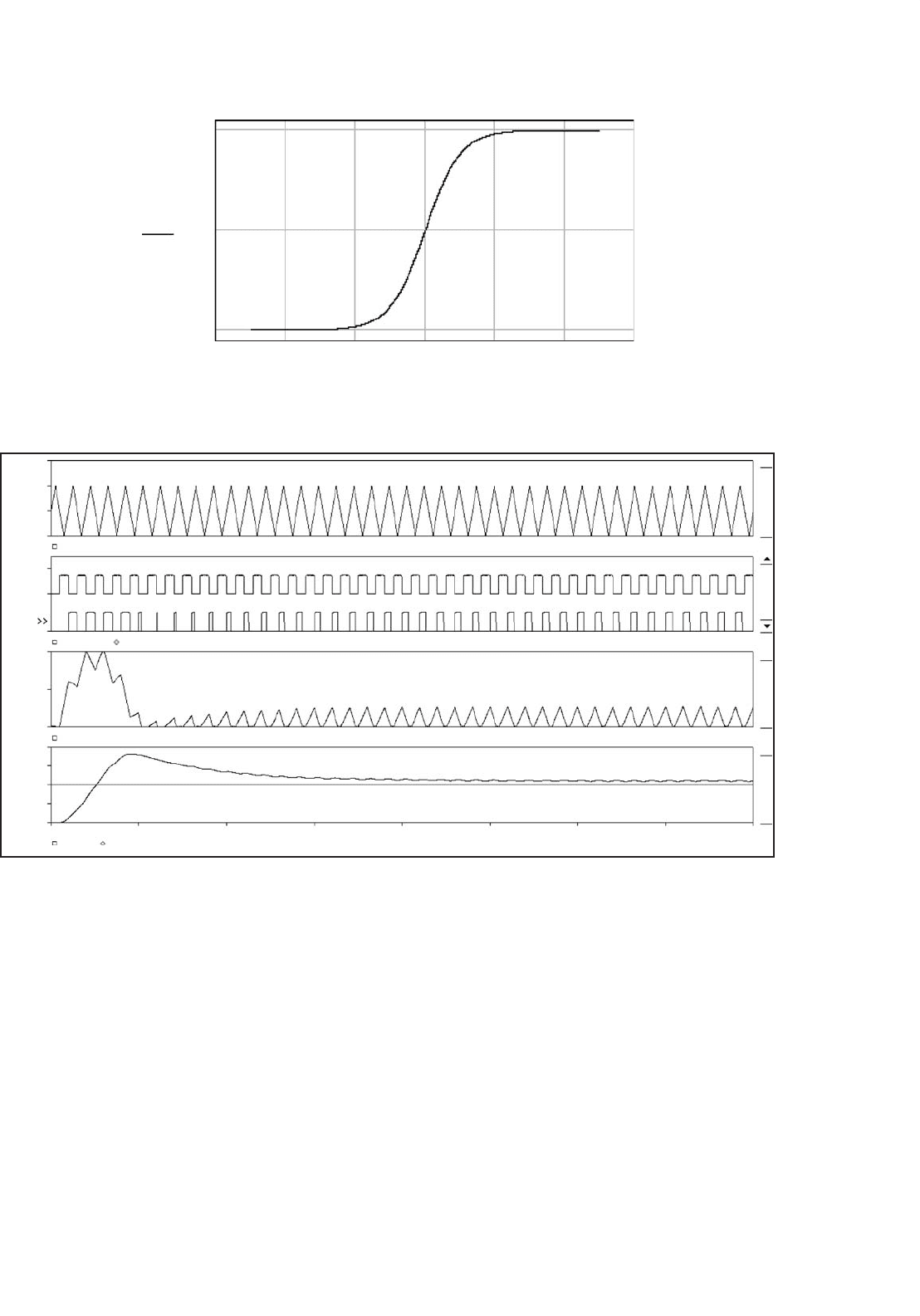
1124 M. Giesselmann
tanh - Function
1
1.1
–1.1
tanh(x)
0
–1
–6 –4 –2 0 2 4 6
x
FIGURE 41.2 Plot of a hyperbolic tangent function used to generate smooth PWM signals.
1.5V
1.0V
0.5V
20V
2.0A
–30V
SEL
4.0A
0A
50.0V
37.5V
25.0V
12.5V
0V
0s 0.5ms 1.0ms 1.5ms 2.0ms 2.5ms 3.0ms 3.5ms 4.0ms
Time
Output Voltage
Triangle Voltage
Gate Voltages
Inductor Current
0V
0V
V (Triangle)
V(1
+,1–)
I(L1)
V(Out) 25V
V(2
+,2–)–30
FIGURE 41.3 Output waveforms for the synchronous buck converter.
long as they operate with continuous inductor current. The
time-averaged model has the advantage that it can run much
faster since it does not have to follow each switching transi-
tion. It is also possible to perform DC and AC sweep analyses.
A DC sweep would sweep the duty cycle over a wide range
and show the output voltage as a function of the duty cycle.
An AC sweep analysis would sweep the frequency of an AC
signal, which is superimposed on top of the duty cycle bias
signal. The AC sweep allows the study of the behavior of the
converter, including a feedback control system, in the fre-
quency domain for traditional stability analysis and system
tuning. A detailed description of this time-averaged modeling
technique, including detailed examples is given in [4].
To illustrate the capabilities of the PSpice
simulation pro-
gram, the next example shows a complete three-phase inverter
bridge using six power MOSFETs. This circuit is shown in
Fig. 41.4. Note that free-wheeling diodes are an integral part
of every power MOSFET and are not shown separately. The
inverter drives a three-phase load, which could represent an
induction motor for a singular operating point. The load is
connected to the inverter output terminals with so-called con-
nection bubbles. Due to the number of elements involved, the
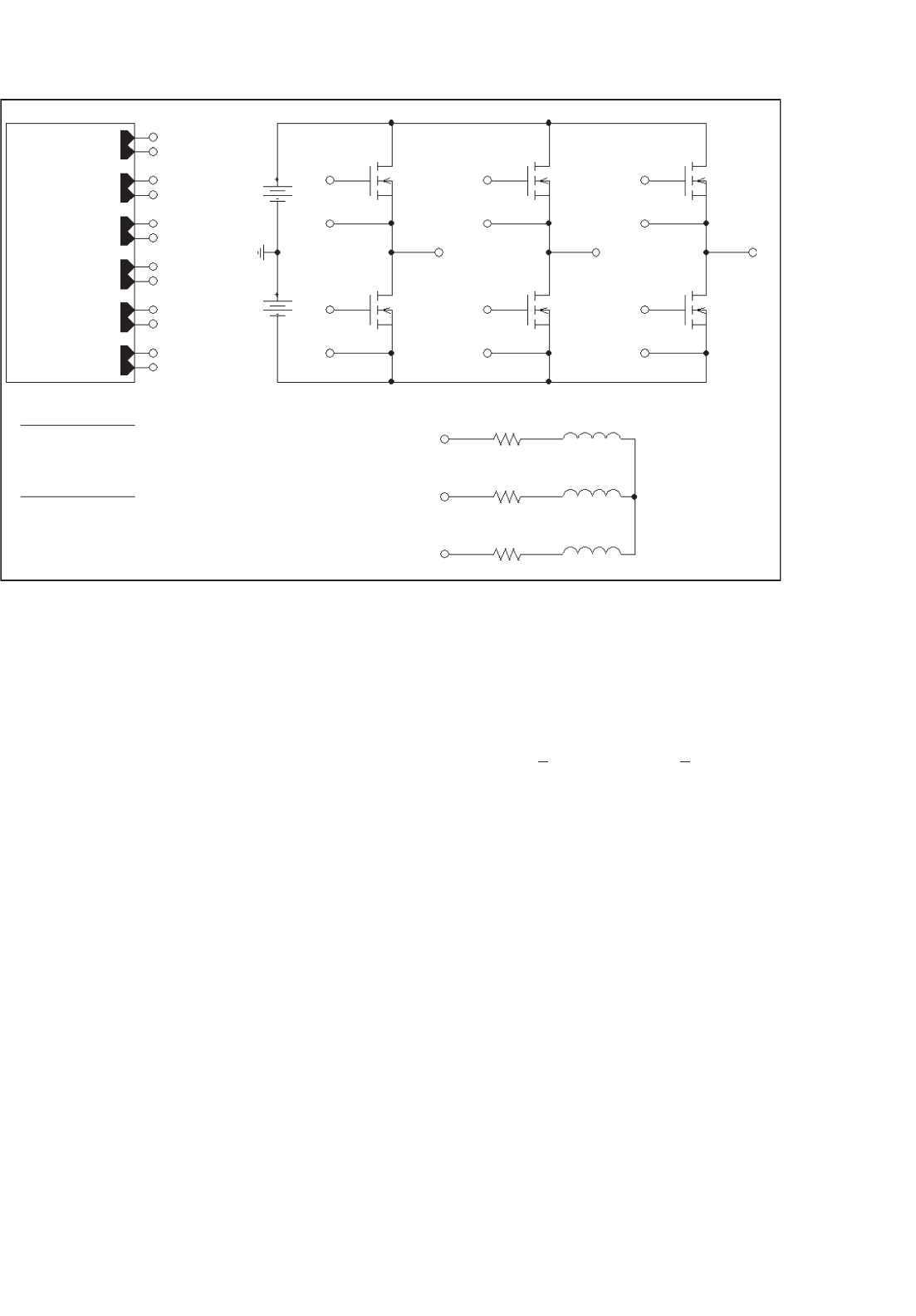
41 Computer Simulation of Power Electronics and Motor Drives 1125
PWM_Generator
Pos
M2M1
M4 M5
25
25
25 150mH
150mH
150mH
M6
M3
IRF150
IRF150IRF150
IRF150IRF150
IRF150
Neg
A
A
A
B
B
B
C
C
C
150V
150V
Vbus+
Vbus−
2+
1+
3+
4+
6+
5+
2−
1−
3−
5−
6−
4−
1+
1+
2+
3+
4+
5+
6+
6−
5−
4−
3−
2−
1−
1−
2+
2−
3+
3−
4+
4−
5+
5−
6+
6−
PARAMETERS:
PARAMETERS:
M_A = 0.8
AC_FREQ = 60
AC_AMP = {m_a}
FSW = 3.6k
PI = 3.14159265
R_load_a
R_load_b
R_load_c L_load_c
L_load_b
L_load_a
FIGURE 41.4 Circuit for a three-phase inverter with MOSFETs.
circuit for the gate drive-signal generation is contained in a
hierarchical block. Blocks like this are available from the main
toolbar in the schematic editor. Selecting “Descend Hierarchy”
for the block called “PWM_Generator” reveals the subcircuit
which is shown in Fig. 41.5.
The hexagonal shaped symbols named “1+,” “1−,” “2+,”
etc. are called interface ports. These interface ports provide the
connection between the subcircuit and the ports of the hierar-
chical block above. Here the connection is to the ports (dots)
on the “PWM_Generator” block. The interface ports are cre-
ated by simply drawing a wire up to the boundary of the block.
The name of the port is initially generic, “Px,” where x is a run-
ning number, but can be easily edited by double-clicking on
the generic name. After drawing a block and creating all the
ports, right-clicking the “Descend Hierarchy” will open up a
schematic page for the subcircuit which has all the appropri-
ately named interface ports already in it. Additional details on
hierarchical techniques can be found in [5].
The circuit shown in Fig. 41.5 is similar to the gate-drive
generation circuit discussed before. Circuits like the circuit
shown in Fig. 41.1, compare a triangular carrier with one or
more reference signals. In this case, three reference signals,
one for each phase, are used. The triangular carrier signal is
symmetrical with respect to the time axis. The values cover the
range from −1.0 to 1.0. The equation for the triangular carrier
for PWM modulation for AC reference signals is given by the
Eq. (41.2).
E
Tri
(
t
)
:=
2
π
a sin
sin
2πf
s
t +
π
2
(41.2)
The three reference signals are sinusoidal signals with equal
amplitude and a relative phase shift of 120
◦
. For linear mod-
ulation, the amplitude range of the reference signals is limited
to the amplitude of the triangular carrier, e.g. 1 V. The ratio
of the reference wave amplitude and the (fixed) carrier ampli-
tude is called amplitude modulation ratio “m_a.” In the circuit
shown in Fig. 41.4 “m_a” has a value of 0.8. This value is
defined by a parameter symbol and represents a global param-
eter, which is visible throughout all levels of the hierarchy.
The phase to neutral voltage amplitude of each inverter leg
is equal to “Vbus+” (shown in Fig. 41.4) multiplied with the
amplitude modulation ratio. The frequency and waveshape of
the phase to neutral voltage of each phase leg is equal to the
reference waveform, if the high-frequency components result-
ing from the carrier wave are filtered away. This way, each
inverter leg can be viewed as a linear power amplifier for
its reference voltage. In fact, in drive applications, inverters
are often called “servo-amplifiers.” The load typically reacts
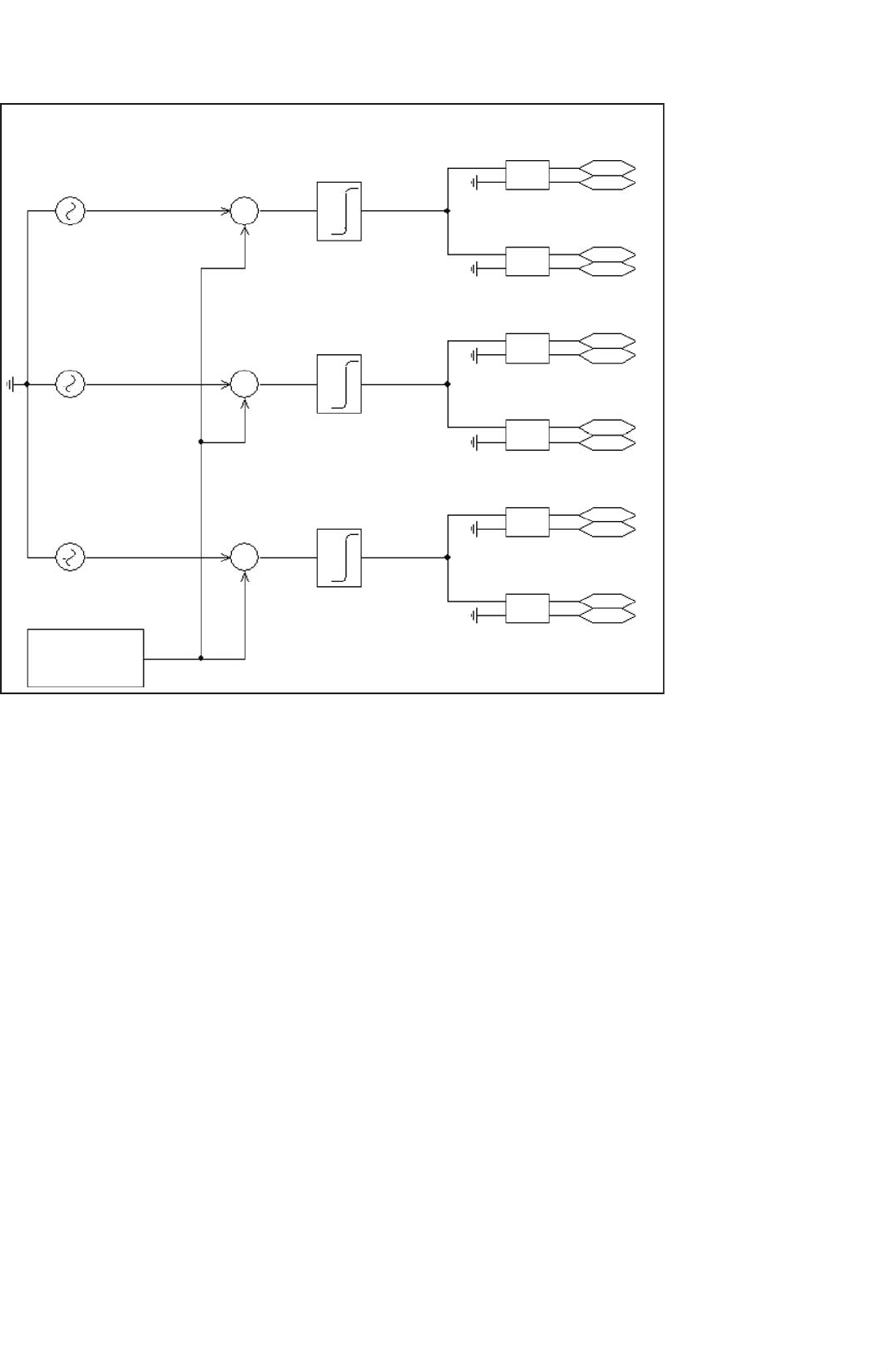
1126 M. Giesselmann
FREQ = {AC_freq}
PHASE = +120
VAMPL = {AC_amp}
FREQ = {AC_freq}
FREQ = {AC_freq}
PHASE = −120
PHASE = 0
VAMPL = {AC_amp}
VAMPL = {AC_amp}
V_c
V_b
V_a
V_ref_c
V_ref_b
V_ref_a
Vtriangle
PWMc
PWMb
PWMa
500
500
+15
+15
−15
−15
500
+15
−15
3−Phase SPWM Generator:
Level Shifter and Driver
+
−
+
−
+
−
(2/Pi)*
Asin(Sin
(2*Pi*Fsw*Time
+Pi/2))
EVALUE
EVALUE
EVALUE
EVALUE
EVALUE
EVALUE
IF(V(%IN+)<–2.0, –V(%IN+),0)
IF(V(%IN+)>2.0, V(%IN+),0)
IF(V(%IN+)<–2.0, –V(%IN+),0)
IF(V(%IN+)<–2.0, –V(%IN+),0)
IF(V(%IN+)>2.0, V(%IN+),0)
IF(V(%IN+)>2.0, V(%IN+),0)
E_a+
1+
2+
3+
4+
1−
2−
3−
4−
5+
5−
6+
6−
IN−OUT−
IN−OUT+
IN−OUT−
IN−OUT+
IN−OUT−
IN−OUT+
IN−OUT−
IN−OUT+
IN−OUT−
IN−OUT+
IN−OUT−
IN−OUT+
E_b+
E_c+
E_a−
E_b−
E_c−
+
−
+
−
+
−
FIGURE 41.5 PWM generation subcircuit for a three-phase MOSFET inverter.
only to the low-frequency components of the inverter output
voltage. The high-frequency components, which include the
triangular carrier frequency (also called switching frequency)
and its harmonics, are typically “just a blur” for the load. This
is especially true in recent times, where switching frequencies
of 20 kHz and above are possible. As an added benefit, audible
noise is avoided at these frequency levels.
The circuit involving the soft-limiter and level-shifter/high-
side driver in Fig. 41.5 is very similar to the circuit for the
synchronous buck converter, except for the fact that the load
current is not monitored. The control functions for the “E_x+,
E_x−” sources, where x denotes the phase, are chosen such
that the activation voltage levels are ±2 V. If the output voltage
of the soft-limiter is between −2 and +2 V, no MOSFET is
activated, and shoot-through, meaning a short circuit between
the positive and negative bus, is avoided.
Figure 41.6 shows the simulation results for the three-phase
inverter. The time scale is slightly stretched, to better show
the details of the PWM signals. The line-to-line voltage V
AB
and the load current in all three phases are shown. Due to the
inductors contained in the load, the current cannot instan-
taneously change and follow the PWM signal. Therefore the
load currents are almost pure sinusoids with very little ripple.
This is representative of the real line currents in induction
motors.
Figure 41.7 shows an example where the MOSFETs in
Fig. 41.4 have been replaced with insulated gate bipolar tran-
sistor (IGBT). The particular IGBT shown here is included in
the library of the evaluation version. Note that free-wheeling
diodes are needed, if IGBTs are used. The free-wheeling diodes
carry the load current when the IGBTs are turned off to pro-
vide a continuous path for the current. This is very important,
since the load can have a substantial inductive component.
Whenever the diodes are conducting, energy flows momen-
tarily back to the source. In the case of power MOSFETs, the
diodes (often called body diodes) are an integral part of the
device. In the symbol graphic of PSpice
these body diodes are
not shown for MOSFETs. For this circuit, the gate-drive circuit
and the results are the same as for the three-phase bridge with
power MOSFETs.
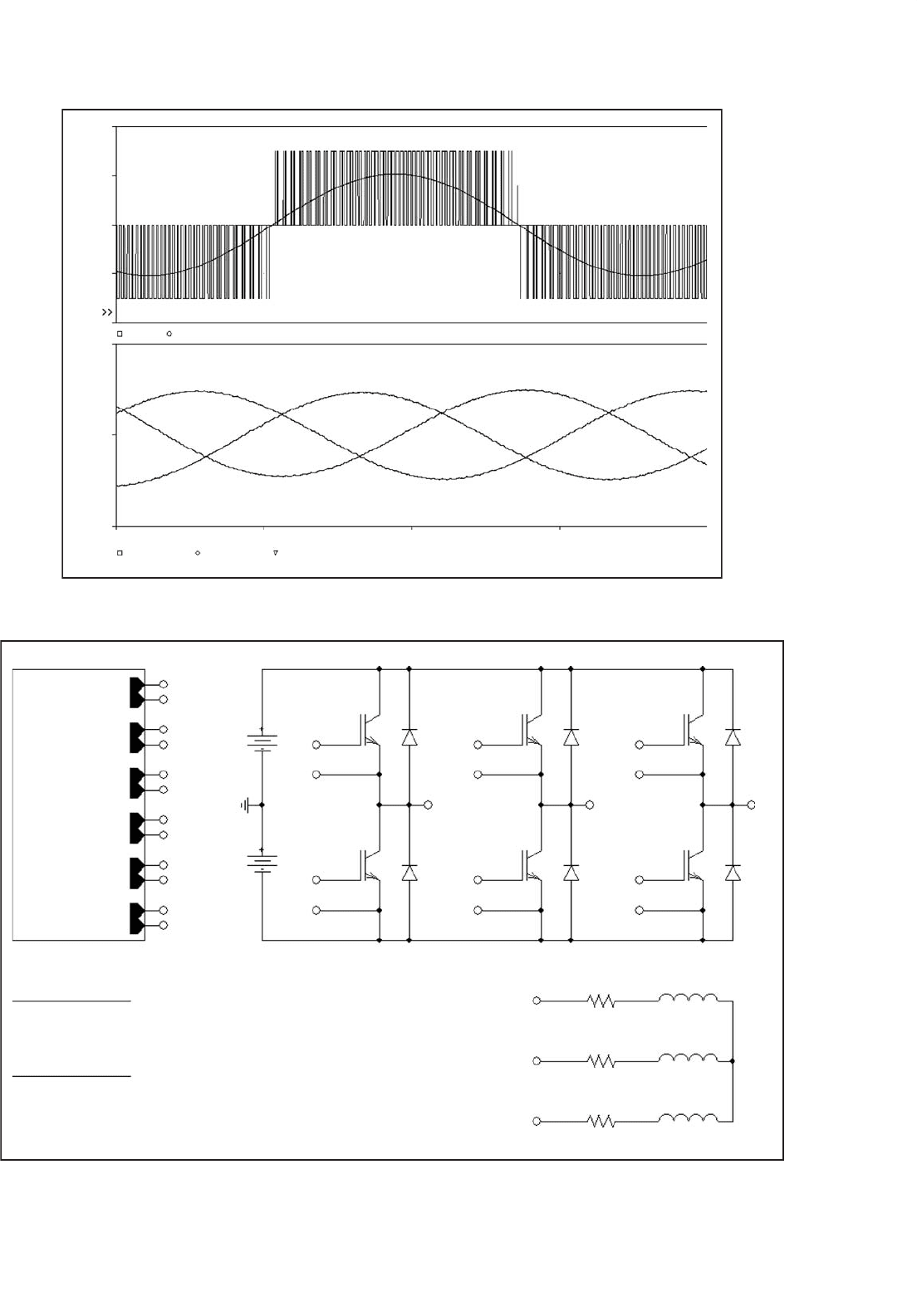
41 Computer Simulation of Power Electronics and Motor Drives 1127
400V
200V
–200V
–400V
SEL
4.0A
–4.0A
0A
10ms 15ms 20ms 25ms 30ms
Time
I (R_load_a) I (R_load_b) I (R_load_c)
Line Currents in the Load:
Line to Line Voltage Vab:
V(A,B)
150
*
(V(PWM_Generator.V_ref_a) – V(PWM_Generator. V_ref_b))
0V
FIGURE 41.6 Output waveforms of the three-phase inverter with MOSFETs.
PWM_Generator
150V
150V
Vbus+
Vbus+
PARAMETERS:
PARAMETERS:
M_A = 0.8
AC_AMP = {m_a}
AC_FREQ = 60
FSW = 3.6k
PI = 3.14159265
Neg
IGBT2
IGBT1
Pos
IGBT3
IGBT4 IGBT6
IGBT5
25
25
25 150mH
150mH
150mH
A
B
C
R_load_a
R_load_b
R_load_c L_load_c
L_load_b
L_load_a
1+
1−
1−
3−
2+
2−
2−
3+
3−
4+
4−
5+
5−
6+
6−
1+
1−
2+
2−
3+
3−
4+
4−
5+
5−
6+
6−
1+
2+
A
AB
C
C
B
IXGH40N60 IXGH40N60
IXGH40N60IXGH40N60
IXGH40N60
IXGH40N60
Da
+
Db
+
Dc
+
Dc
−
Db
−
Da
−
4+
4− 6−
5−
3+
5+
6+
FIGURE 41.7 Three-phase inverter circuit with IGBTs.
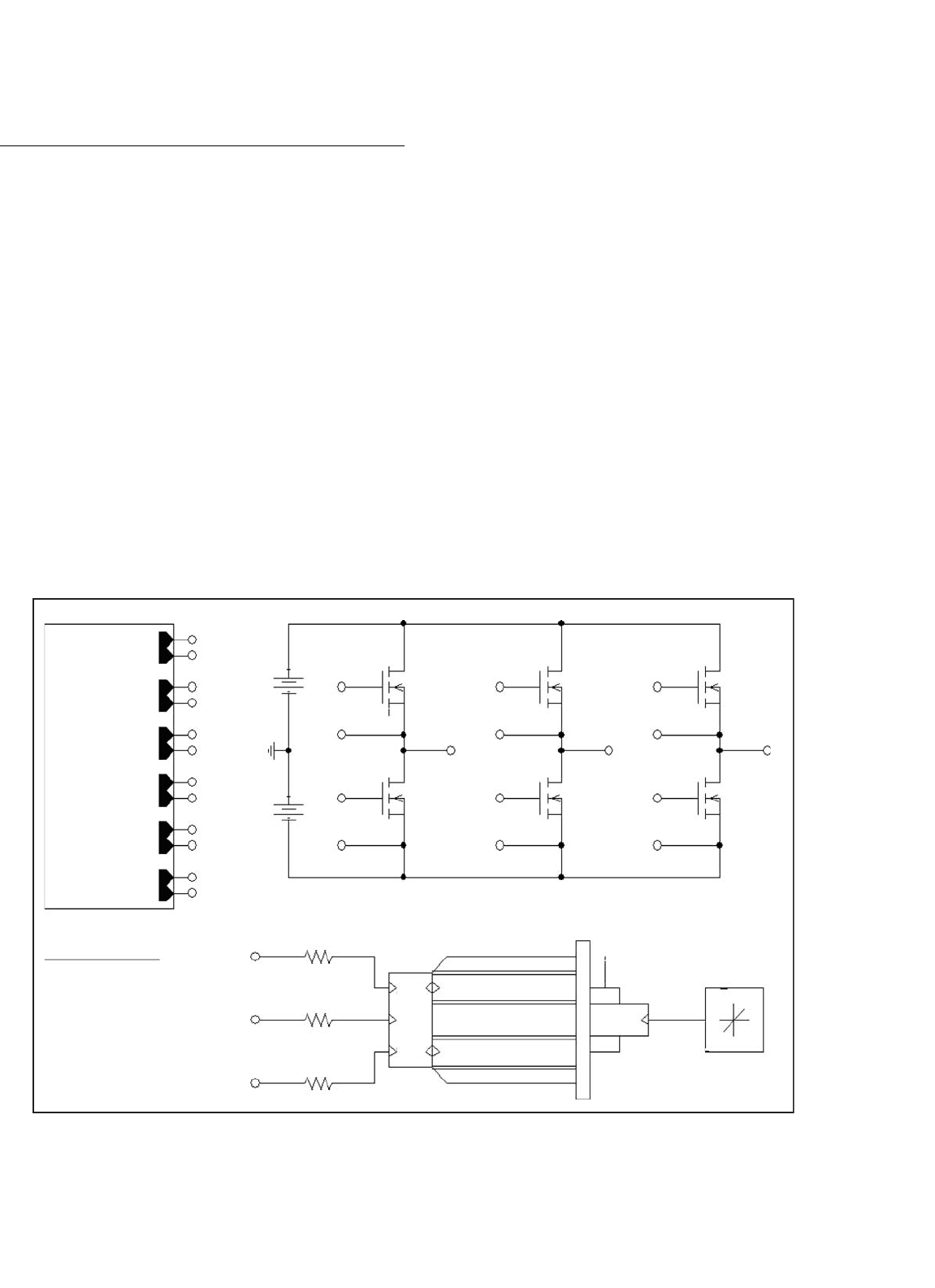
1128 M. Giesselmann
41.4 Simulations of Power Electronic
Circuits and Electric Machines
In the following, the start-up of an induction motor, fed by
the three-phase inverter shown in Fig. 41.4, is presented. For
this purpose, the simple passive load in Fig. 41.4 is replaced
by an induction motor. For this and further discussions, it
is assumed that the reader is familiar with the theory of
induction machines. A number of excellent references are
given at the end of this chapter [2, 3, 6, 7]. The induc-
tion motor symbol represents the electro-mechanical model
of an induction motor. The model is suitable for studies of
electrical and mechanical transients as well as steady-state con-
ditions. The output pin on the motor shaft represents the
mechanical output. The voltage on this pin represents the
mechanical angular velocity using the relation 1 V = 1 rad/s.
In addition, any current drawn from or fed into this termi-
nal represents applied motor or generator torque according to
the relation 1 A = 1 Nm. Due to these definitions, the elec-
trical power associated with the voltage of the motor shaft
(with respect to ground) is identical to the mechanical power.
Following the well-known theory, the induction motor model
has been derived for a two-phase (direct and quadrature, D, Q)
PWM_Generator
Pos
200V
200V
Vbus+
Vbus−
IRF150
IRF150 IRF150
IRF150 IRF150
IRF150
M6
M3
M2
M5
M4
M1
Motor1
R_sense_a
R_sense_b
R_sense_c
C
B
A
Neg
4−
2−
2+ 4+
1−
3−
5−
Torque
Omech
Ind_Motor
1+
1−
2+
2−
3+
3−
4+
4−
5+
5−
6+
6−
1+
1−
2+
2−
3+
3−
4+
4−
5+
5−
6+
6−
PARAMETERS:
FREQ_AC = 60
OMEGA = {2*Pi*Freq_AC}
PI = 3.14159265
1m
1m
1m
A
B
C
D
D
QQ
6+
A
A
B
B
C
C
1+
3+
5+
Lin_Load1
4.0 Nm @
1765 RPM
6−
FIGURE 41.8 Induction motor start-up with three-phase inverter circuit.
equivalent motor. Attached to the motor is a bidirectional two-
phase to three-phase converter module. This module is voltage
and current invariant. This means that the voltage and current
levels in the two-phase and the three-phase machine are equal.
Consequently, the power in the two-phase machine is only two
third of the power in the three-phase circuit. This is accounted
for in the calculation of the electromagnetic torque (factor
3/2; see Eq. (41.4)). The internally generated torque can be
monitored on the output labeled “Torque” on top of the sleeve
around the motor shaft. The linear load in Fig. 41.8 is a symbol
that represents an appropriately sized resistor to ground.
In Fig. 41.8 the motor is represented by a custom symbol
called “Motor1.” A simple hierarchical block could have been
used for the motor, but a custom symbol has been created to
achieve a more realistic and pleasing graphical representation.
The symbol can be easily created with the symbol editor, which
is built into the regular schematics (capture) editor. The editor
provides standard graphical elements (lines, rectangles, circles
etc.) so that professional looking symbols can easily be created.
More details on this are shown in Figs. 41.19 and 41.20 and
the accompanying discussion. Parameters are passed onto the
subcircuit by using the name of the parameter preceded by a
‘@’ symbol. The advantage of passing parameters to subcircuits
